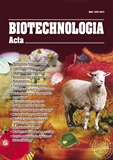ISSN 2410-7751 (Print)
ISSN 2410-776X (Online)

Biotechnologia Acta Т. 16, No. 2 , 2023
P. 35-36, Bibliography 3, Engl.
UDC: 57; 616-092
DOI: https://10.15407/biotech16.02.035
Full text: (PDF, in English)
EFFECTS OF IMIDOPYRAN AND PREDNISONE IN THE TREATMENT OF BABESIOSIOSIS-ASSOCIATED ANEMIA IN DOGS
NEVIDNYK-PRAVDA A.Y.
Oles Honchar Dnipro National University, Ukraine
Aim. To investigate the development and treatment with imidopyran and prednisolone of hemolytic anemia in dogs caused by the protozoan parasite Babesia canis.
Methods. 17 domestic dogs weighing 5-10 kg aged 2-5 years were used for the study. The parameters of the general blood analysis were determined using the MicroCC-20 Plus automated hematology analyzer (HTI, USA). Microscopy with a Leica DM4 electric microscope (Germany) was carried out to study the condition of erythrocytes, counting the number of leukocytes and platelets.
Results. The main indicator of the development of anemia in animals is the number of erythrocytes, hemoglobin, and hematocrit. Development of babesiosis lead to the hemolytic anemia investigated in dogs before treatment: the number of erythrocytes lower than normal by 20-30%, the level of hemoglobin 40-55%, the average concentration of hemoglobin in erythrocytes 10- 18%, hematocrit 20-30% and the number of platelets 40-50%.
Conclusions. The results of the study showed that treatment with imidopyran and prednisolone is effective in cases of babesiosis for dogs caused by the protozoan parasite Babesia canis. Moreover, such treatment decreases the risks of the anemic state development for these animals.
Key words: canine anemia, hemorrhagic anemia, imidopyran, prednisone, babesiosis.
© Palladin Institute of Biochemistry of the National Academy of Sciences of Ukraine, 2023
References
...1. Cuq B., Blois S. L., Mathews K. A. Anti-thymocyte serum as part of an immunosuppressive regimen
in treating haematological immune-mediated diseases in dogs. J. Small Anim. Pract. 2017, v. 58, p.
348–354. https://doi.org/10.1111/jsap.12666 Epub 2017 Mar 28.
2. Lobetti R. Changes in the serum urea: creatinine ratio in dogs with babesiosis, haemolytic anaemia,
and experimental haemoglobinaemia. Vet. J. 2012, v. 191, p.:253–256. https://doi.org/10.1016/j.
tvjl.2011.01.027 Epub 2011 Mar 12.
3. Kane B. K., Greer R. M. Human intravenous immunoglobulin use for hematological immune-mediated
disease in dogs. J. Am. Vet. Med. Assoc. 2023. https://doi.org/10.2460/javma.23.01.0043 Online ahead
of print.13.

